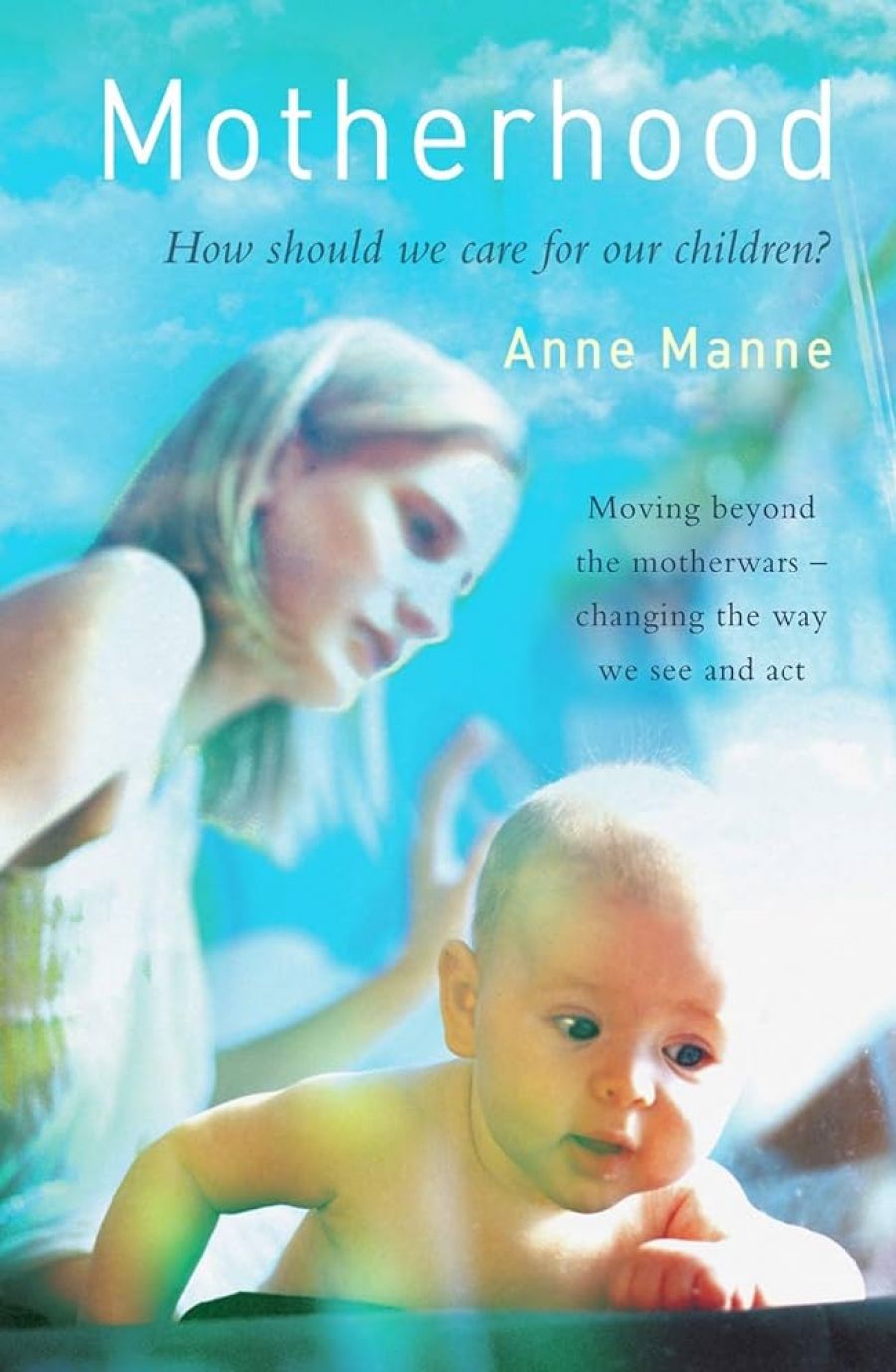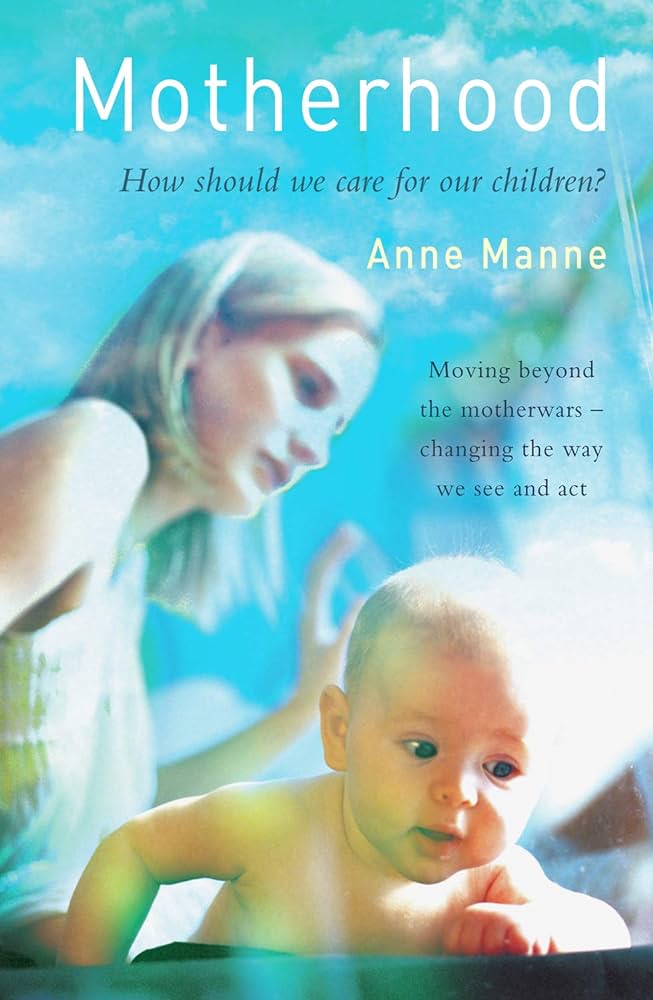
- Free Article: No
- Contents Category: Society
- Review Article: Yes
- Article Title: The big picture
- Online Only: No
- Custom Highlight Text:
Anne Manne’s book Motherhood: How Should We Care for Our Children? arguably makes the greatest contribution to the work–family debate in Australia in years. Manne has drawn on a huge range of resources – philosophical, psychological, sociological, economic and political – to create a thesis that shows a way out of the current quagmire of work–family relations.
- Book 1 Title: Motherhood
- Book 1 Subtitle: How should we care for our children?
- Book 1 Biblio: Allen & Unwin, $29.95 pb, 318 pp, 1741143799
- Book 1 Cover Small (400 x 600):

- Book 1 Cover (800 x 1200):

Manne’s book has a fundamentally important starting point: it addresses the needs and desires of not just women but also children. Manne says: ‘I wanted to take those two utterly valuable social goods, women’s emancipation and child well-being, and try to put them together.’ To the vast majority of mothers, this is not revolutionary. We deal with the tension between those two, sometimes conflicting, needs every day. However, in the context of the public work–family debate, starting with an explicit consideration of children’s needs is unusual. Penelope Leach did it in Children First: What Society Must Do – And Is Not Doing – for Children Today (1994), but an astounding number of feminist commentators write whole tomes on working motherhood without any genuine attempt to grapple with children’s needs. Writers such as Joan K. Peters and Anne Summers spring to mind.
In contrast, Manne takes children seriously. She reminds us that feminism is a movement that focuses awareness on the vulnerability of a particular group, and that, as such, its ideas have a ‘profound moral seriousness’. She goes on to state that children are also vulnerable and powerless, and that, unlike women, they are ‘politically mute’. This voicelessness makes ‘thinking and writing about children and justice difficult and our responsibility so heavy’. Further, on a personal level, we must recognise ‘our power over children, and our ability to affect their lives for good or ill’.
For Manne, how we treat children matters. She argues that, contrary to the popular perception of children as eternally resilient, landing on their feet like a cat with nine lives, children are profoundly affected by what happens to them. She looks closely at attachment theory, in particular the radical work of child psychiatrist John Bowlby. Bowlby’s three-volume work Attachment, Separation and Loss (1973–82) did what Manne argues is vital: it got inside the skin of a child, attempting to see the world from a child’s point of view. Bowlby’s findings, although much maligned in recent years, are now being corroborated by new research in neurobiology, specifically research on infant brain development. Brain development ‘is especially rapid and extensive in the first year of life … and is much more vulnerable to environmental influence than we ever suspected’. Adverse early environment may affect later physical and mental health. In other words, how we treat children really matters. There are ways we should care for them, and ways we should not.
Armed with this evidence, Manne tackles a volatile subject: institutional childcare for toddlers and babies. Manne examines the damning evidence that, while some childcare in Australia is high quality, most is not. Experts universally agree that a ratio of one carer to five babies constitutes poor quality care, and yet that is what government regulations mandate in most states. Most child-care centres, particularly the increasingly dominant private centres with a primary profit motive, have extremely high staff turnover, preventing children from forming vital attachments to carers. One survey of child-care students found that every single trainee said they would never place their own child in childcare after what they had seen. Further, Manne reviews the significant body of research now demonstrating that, regardless of quality, early and/or extensive use of childcare presents a risk factor for aggression and problem behaviour in children. No matter how high quality the care, other studies show that interactions between a paid child-care worker and a baby do not come close to the quality of interactions between a loving parent and child. Manne has the sense to say what most parents instinctively know: that from a baby’s point of view, love matters.
Despite these concerns about children’s well-being, there is a staggering resistance to criticism of childcare, in academic and public fora. Manne identifies this as an example of what Irving Janis has called Groupthink: the ‘inability to insert anything outside the assumption of the dominant group’; the danger that independent critical thinking will be silenced. Because institutional childcare has been seen as an indispensable linchpin in the honourable feminist project of emancipating women, some academics are intractably and ideologically opposed to criticisms of care. Manne identifies the trend whereby academics and even paediatricians would rather sweep concerns about children’s well-being under the carpet than make a parent feel guilty. Despite the glaring power imbalance, adult vulnerability seems more important than tiny babies.
Manne makes it clear that, in their unquestioning support of institutional care for babies and toddlers, academic élites are out of step with the majority of parents. Studies, both here and overseas, have found overwhelming parental preference for mother care at home when children are very young (in Australia today, a mere five per cent of babies under one use long daycare; ninety-five per cent do not, as a direct consequence of this preference). Given a choice between publicly funded day care or time off work and at-home allowances, most women will choose the latter. Manne explodes the popular belief that Scandinavian countries are leading the way by providing universal day care for babies; they are in fact leading the way by assisting women to stay at home in their children’s early years. Manne points out that ‘if the trajectory of public policy pushes families towards institutional childcare and punishes parental care, it is in clear violation of the principles of a democratic state’.
Which brings us to Manne’s ultimate conclusion: ‘an alternative and humane path through the feminist revolution, which maintains an attentiveness to the needs of children.’ She argues for ‘active neutrality’ in state family policy. That is, active support for all parents’ preferences, rather than privileging some over others. An Australian example was the bipartisan support for ‘maternal equity policies – an equal allowance of initially $3000 but eventually $5000 on the birth of a child, regardless of whether women work or not’.
Manne wants to see a society where neither women nor children are offered substandard life options. Women should not be forced to choose between the old dependent, vulnerable homemaker model, which denied us the opportunity to use all our skills, and the new work-centred model, which denies us the time to nurture our own children. Children should not be offered substandard care at the most vulnerable time of their lives. Manne argues that three years of parental leave, short working days, sequencing, career breaks, at-home allowances and best-practice, community-based childcare would serve women’s needs to work and children’s needs for care. Manne emphasises that these policies should be available to mothers and fathers, to be used at their discretion.
This book covers huge ground. It is the big picture with detail. Many issues ignored in public discussions of work and family are vigorously confronted: the explicit antipathy of some work-centred feminists to motherhood, an antipathy that other feminists do not share; the dovetailing of work-centred feminism with the demands of the new capitalism in which work has become god; the ‘care penalty’ that is imposed on women, but does not have to be imposed, when they provide the bulk of indispensable unpaid labour in the community; and finally, the rise of ‘affluenza’, that frenzied cycle of earning and spending that turns some homes from havens to hells.
Perhaps the singular achievement of the book is highlighted in its title. Manne has the courage to write about motherhood without cynicism. She celebrates the intense love that a mother has for her child and that a child has for his or her mother. More importantly, she has the courage to persuade us that we should all treat that precious love with care.


Comments powered by CComment